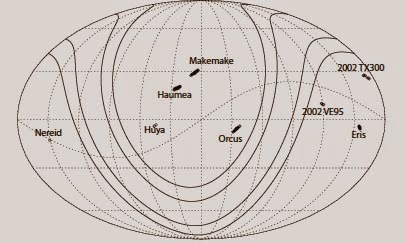The Dwarf Planet Makemake is one of the three largest
Trans-Neptunian Objects, with a diameter of about 1400 km, along with Pluto and
Eris (2370 km 2330 km respectively). Makemake is thought to have a roughly circular orbit,
remaining at about 45.7 AU from the Sun, while those of Pluto and Eris are more
eccentric, taking them substantially closer to and further away from the Sun
during the course of a single orbit (Pluto even spends part of its orbit inside
the orbit of Neptune). All of these bodies are thought to have icy surfaces,
and while those of Eris and Pluto are thought to undergo substantial heating
and cooling as their distance from the Sun varies, leading to significant
reworking of surface ices, that of Makemake if thought to remain close to 37K
throughout its orbital cycle. This in theory means that the surface of Makemake
should have undergone little reworking, and could therefore preserve a
composition from early in the history of the Solar System.
In a paper published in the journal Astronomy & Astrophysics on
10 April 2015 and on the arXiv database at Cornell University Library on 9
April 2015, Vania Lorenzi of the Fundación Galileo Galilei, Noemi Pinilla-Alonso of
the Department of Earth and Planetary Sciences at the University of Tennessee
and Javier Licandro of the Instituto Astrofísico de Canarias and the Departamento deAstrofísica at the Universidad de La Laguna, describe the results of a
spectrographic analysis of the surface of Makemake carried out with the medium-resolution
spectrograph ISIS on the 4.2 m William Herschel Telescope at the Roque de LosMuchachos Observatory on La Palma Island in the Canaries.
While all ices reflect light, specific ices will only do so at
specific wavelengths, enabling astronomers to determine the surface composition
of remote icy objects by analysing the spectra of sunlight reflected from them.
Lorenzi et al. were able to
observe Makemake for 6.3 hours, 82% of one of its rotational periods (a ‘day’ on
the surface of the Dwarf Planet), obtaining good data that enabled them to
assess the composition of 70% of its surface. They found that the studied
surface was homogenous (unvarying), which supports the idea that it is
relatively unperturbed. The surface of Makemake appears to be covered by
granular ice, containing a mixture of methane (CH4) and nitrogen (N2).
See also…
For over a century Pluto was the only known bright object in the
Solar System beyond Neptune, but in the past two decades a large number of such
objects...
 Observations of New Horizons candidate bodies with the Hubble Space Telescope. The New Horizons Spacecraft was launched in January 2006, and is due to pass through the Pluto
System (Pluto is now recognized to be...
Observations of New Horizons candidate bodies with the Hubble Space Telescope. The New Horizons Spacecraft was launched in January 2006, and is due to pass through the Pluto
System (Pluto is now recognized to be...
The dwarf planet Pluto will reach opposition slightly before 3.00 am GMT
on Friday 4 July 2014; this means that it will be directly opposite the
Sun in the sky when viewed from Earth, on this occasion in the...
Follow Sciency Thoughts on Facebook.



